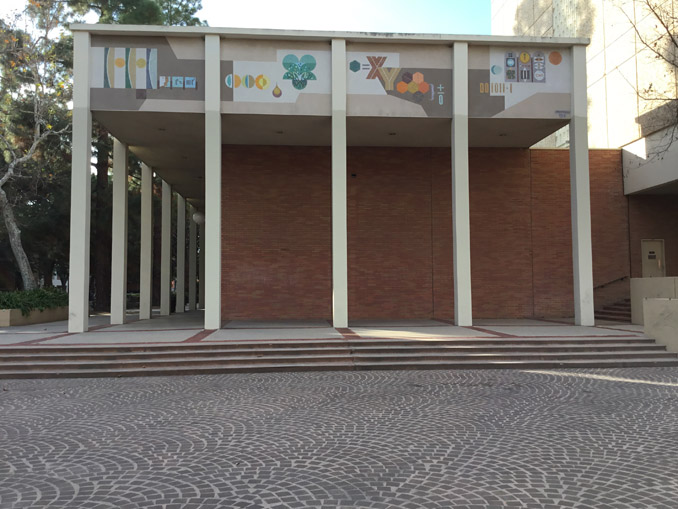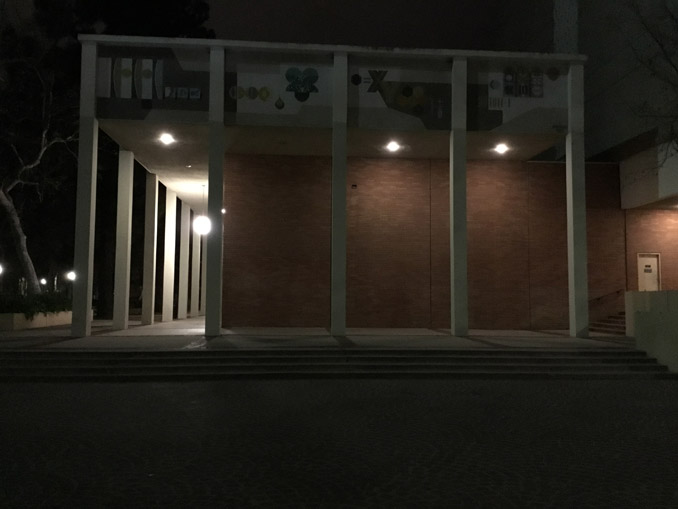The Apple iPad Pro Review
by Ryan Smith, Joshua Ho & Brandon Chester on January 22, 2016 8:10 AM ESTCamera
While it’s pretty much a universally terrible idea to use a tablet as your primary camera, for something like video chat or in an emergency it’s better to have one than not. In the case of the iPad Pro, the camera is essentially identical to what we saw with the iPad Air 2, which is to say an 8MP 1.1 micron 1/4” sensor, with an F/2.4 aperture and 3.3mm focal length, which translates to a 35mm equivalent focal length of 31mm. There’s no PDAF or anything fancy going on here, so it’s pretty much a guarantee that the camera is the exact same module that we saw with the iPad Air 2. The front facing camera is still a 1.3MP F/2.2 2.65mm focal length module, which leads me to believe that it too is shared with the iPad Air 2. I honestly don’t see any difference between the iPad Air 2 and iPad Pro cameras, so rather than spending time dwelling on those this comparison will be focused upon how it compares to popular smartphones and the tablet competition. As I don’t have a tripod mount that can actually fit the iPad Pro, I’ve elected to forgo some of our standard latency tests to avoid presenting data with confounding variables.
| Daytime Photography Scene 1 |
In our first daytime scene the iPad Pro is actually not that far off from the iPhone 6s. If you look closely it’s obvious that there is less detail to be seen, but it’s honestly quite difficult to see the difference. Relative to the iPhone 6, detail is almost identical. For a camera that should basically be never used for the kinds of photos I’m taking for this review, the camera will work well in a pinch. By comparison the Pixel C is rather disappointing. Even in this ideal condition, detail is visibly worse when compared to the iPad Pro. I’m not sure whether this poor showing is caused by camera shake or AF issues but in general the AF system for the Pixel C had some pretty noticeable issues in general. There are also some obvious problems with color noise despite base ISO, which is shocking.
| Daytime Photography Scene 2 |
In the interest of trying to collect more than one data point for presentation in the review, I tried another scene. Once again, the iPhone 6s shows a minor resolution lead and the iPad Pro is pretty close to the iPhone 6 here. By comparison while there isn’t any obvious weirdness going on the Pixel C clearly has less detail and a noticeable amount of color noise, which is surprising even for a tablet camera. Color noise is one of the most distracting things in any photo, so I’m always concerned when any mobile device has a camera where the JPEG output shows color noise.
| Low Light Photography Scene 1 |
| Low Light Photography Scene 2 |
Moving on to the low light testing, we clearly see the disadvantage that comes with smaller pixel sizes. The iPad Pro is just clearly worse than the iPhone 6 and 6s here. The 6s Plus is the clear winner of this test. While the iPad Pro has dark output, it’s miles better than the Pixel C and Nexus 9, both of which show enormous amounts of color noise. The Tegra X1 and K1 ISP for whatever reason is struggles with doing things like hot pixel compensation in low light, as in the dark areas of the photo there are obvious bright speckles of pixel noise.
| Low Light Photography Scene 3 |
In another low light scene we see the same sort of ordering that was in the previous scene. The iPad Pro is acceptable here, but the iPhone 6, 6s, and 6s Plus are all clearly superior. However, the iPad Pro is clearly superior to the Pixel C and Nexus 9 on the basis of better detail and noise reduction. Unlike most smartphones I don’t really see a huge difference in how well everything freezes motion here, but I suspect this might just be because the entire image for the Pixel C and Nexus 9 is so lacking in detail.
Video
| 1080p30 Video |
Looking at video performance, the iPad Pro noticeably lags behind the iPhone in feature set, which isn't entirely unsurprising given that the camera on any tablet should be strictly reserved as a fallback for when you can’t get to a smartphone or literally anything else. 1080p30 is encoded with H.264 high profile at 17 Mbps, with around 82 Kbps single channel AAC audio. For the most part, quality here is actually comparable to the iPhone 6 and 6s in daytime, with a noticeably tighter crop due to the longer 35mm equivalent focal length. The iPhone 6s Plus is again the obvious winner here though, due to its use of OIS in video. By comparison, the Pixel C shows clearly less detail, and the higher contrast leads to worse detail in areas like the road and in shadows.
| Slow-Motion Video |
In 720p120, the iPad Pro is clearly worse than the iPhone 6s and 6s Plus just by virtue of not supporting 1080p here. That's not exactly surprising, but as a result the quality looks to be roughly comparable to the iPhone 6. Given that both are using H.264 high profile at 30 Mbps it’s not exactly a surprise though. The Pixel C and Nexus 9 are both unable to participate in this test at all as they don’t support slow motion video, which might be an ISP limitation of some sort as we’ve seen Nexus devices on the smartphone side with support for slow motion video.
Overall, camera performance on the iPad Pro is probably as good as it gets for tablets, but it's obviously not competitive with the best smartphones. No one should really be surprised that this is the case though, as tablets are basically cameras of last resort, while smartphones are often primary cameras now.
Misc.
On the WiFi side unfortunately I have reason to doubt the validity of our current testing methodology, especially on iOS. As a result for this review we won’t be running any particular benchmarks for the iPad Pro but I never saw any particular issues with WiFi performance on the iPad Pro, which uses Broadcom’s BCM4355 WiFi/BT combo chipsets.
I also don’t have any particular equipment to really test speaker quality to its full extent, but subjectively the speakers are some of the best I’ve ever experienced on a mobile device in terms of sheer volume and frequency response. The speaker amps are shared with the iPad Air 2, which is Maxim Integrated’s MAX98721 IC. The audio codec/DAC is Cirrus Logic’s CS42L81, which isn’t entirely unsurprising given how most every Apple mobile device seems to use a Cirrus Logic codec of some sort.
I also found a number of interesting design wins, which include TI’s BQ27540 for the battery fuel gauge, and an MCU related to the Orion dock that seems to handle accessories like the Smart Keyboard. This MCU is connected over i2c, with some suggestion that this connector can act as a USB port, but I haven’t been able to figure out much else about this system.















408 Comments
View All Comments
AirunJae - Wednesday, February 10, 2016 - link
Notice he said nothing about the iPad being better than the Surface, just that "...stop being a Fanboy" and "Surface Pro 4 wins" is ironic because you're following you plea for the reviewers (I assume) to stop being fanboys with some fanboyism of your own.MaxIT - Saturday, February 13, 2016 - link
Not running Windows make it better by definition....Delton Esteves - Wednesday, February 17, 2016 - link
Are you out of your mind? Not running full OS makes it worstdarwiniandude - Monday, February 29, 2016 - link
"Full OS"Drivers. Malware. Compatibility issues (install old piece of software, have it break new software). No low latency audio, audio not a priority. Any decent software is designed for mouse and keyboard, not tablet interface. For my purposes Surface is a waste of space. In fact we recently bought used a Surface 2 256GB for $100. Owner thought it was faulty. Wifi didn't work. Touch screen didn't work. Trackpad didn't work. Everything looked fine with the software config except there was malware. Wiped and reset up, works fine. But I can't use it for anything because the software I want to run isn't on Windows. The tablet ecosystem is elsewhere. Windows store is a joke. So it sits gathering dust.
Alecgold - Friday, February 12, 2016 - link
You've written a lot of BS.There is lighting to USB, so what is your point?
Lighting to hdmi adapter is available as well..
Lighting to memory card (with usb-3 speeds) is available
Kickstand is build in in the keyboard or smartcover.
Not everybody needs a pen, so why include it?
I don't need USB, HDMI, SD-cards or kick stands.
So why include it if you don't need it?
Keyboard is expensive indeed, but it's really good...
Who needs backlit, at night you need to sleep
I'm really annoyed by the trackpad on the surface, doesn't work when I want to, does work when I don't want to
Function keys are on the screen if needed or can be swiped up, not as convenient, but I prefer the small depth of the keyboard.
Why would I need to rest my hand? It rests on the table I'm writing on.
Setup was really fast an easy, what is complicated?
The iPad is a tablet so therefore it runs a mobile os, it has great battery life, I can do everything I need to. I just can't OCR PDF's, that is the only thing I still miss.
I'm a professional a consultant, I can do everything I need to, so there it is, it's used by a professional and therefore an iPad Pro. Just as good reasoning as yours, I guess.
Is the iPad Pro for anybody? Absolutely not. It's expensive, others need more processing power or bigger/better/more complete software. But if you can get by with it, I t's really a good device and a really good experience!
Delton Esteves - Wednesday, February 17, 2016 - link
Lighting to USB, lighting to hdmi adapter and lighting to memory card will cost you extra.The Kickstand which was built in the keyboard is very difficult to set up and has limited positions.
"Not everybody needs a pen". This is not a reason to charge for extra money.
Despite you do not need usb, hdmi, it does not mean they cannot include it. Because a device is made having in mind the general needs and not a single person needs.
You call yourself a Professional and yet you say "Who needs backlit". It seems like everybody has a definition of a Pro device this days.
So you always write on a table?
Writting and tapping on the screen is tiresome, function keys make you more productive.
Constructor - Saturday, February 20, 2016 - link
It is an illusion to believe that "included" items were in any way "free". In fact, for most people they would only pay more for stuff that they'd never use.On the bottom line everybody would have to pay more and there would be more electronic waste. Only the few people who actually used those add-ons might(!) get away slightly cheaper. That's it.
Delton Esteves - Tuesday, February 23, 2016 - link
But at least, they are not charging extra. If you consider Ipad Pro price you will notice that it is already expensive for what it is and what the majority of its Users will use it for. They are charging a lot for zero extra functionality.Constructor - Tuesday, February 23, 2016 - link
I have paid a little more for my iPad Pro than for my iPad 3 four years ago, and the iPad Pro is again a much better tablet than the iPad 3 had been (and it was already a very good one!).And I have paid extra for the Pencil which I actually wanted to use. Other users left the Penicl out and didn't have to pay for it. It's that simple and the way it should be.
So what exactly is the problem supposed to be with me paying for what I want to use, and others not paying for what they don't want to use? That's a really weird mindset from my point of view.
Delton Esteves - Wednesday, March 9, 2016 - link
They should lower Ipad pro price because Apple Pen does not come with it